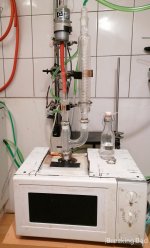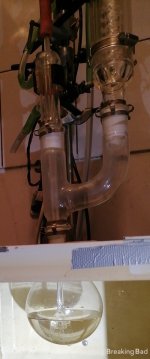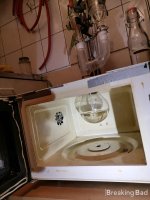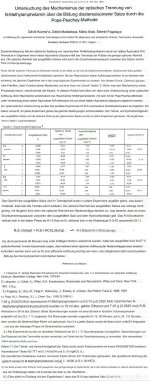William D.
Expert
- Joined
- Jul 19, 2021
- Messages
- 1,055
- Reaction score
- 1,311
- Points
- 113
Amphetamine
Reagents:- 1-Phenyl-2-propanone (P2P) 0.827 g, 6.2 mmol;
- Formamide 3.5 ml;
- Benzene 50 ml;
- Magnesium sulphate (MgSO4);
- Methanol 5 ml (MeOH);
- Hydrochloric acid (15 % aq HCl) 5 ml;
- Distilled water 25 ml;
- Dichloromethane (DCM) 90 ml;
- Sodium hydroxide (NaOH) pellets;
- Sulfuric acid;
- Acetone;
- Pear shaped flask 10 ml;
- Retort stand and clamp for securing apparatus (optional);
- Heating plate;
- Boiling chips;
- Funnel;
- Rotary evaporator (optional);
- Syringe or Pasteur pipette;
- pH indicator papers;
- Beakers (50 mL x2, 100 mL x2);
- Separatory funnel 100 ml;
- Laboratory scale (0.1-200 g is suitable);
- Measuring cylinders 10 mL and 100 mL;
- Glass rod and spatula;
- Laboratory grade thermometer;
- Buchner flask and funnel;
- Filter paper;
1. A mixture of 1-phenyl-2-propanone (P2P) 0.827 g, 6.2 mmol and formamide 3.5 ml is heated at 160-170 ℃ for 16 h in a 10 ml pear shaped flask with a reflux condenser.
2. The mixture is cooled to room temperature.
3. The reaction mixture is extracted with benzene (2x25 ml) is separatory funnel. Extract is dried over magnesium sulphate (MgSO4) and filtered. A dark oil is obtained after benzene evaporation from combined extract.
4. The dark oil is dissolved in a mixture of methanol 5 ml (MeOH) and hydrochloric acid (15% HCl) 5 ml and refluxed with a constant stirring for 2 h.
5. The reaction mixture is evaporated under reduced pressure. Next, the remaining product is dissolved in distilled water 25 ml and extracted with dichloromethane (DCM) CH2Cl2 (2x20 ml).
6. The aqueous solution is alkalized to pH 10 by addition sodium hydroxide (NaOH) pellets and extracted with DCM (2x25 ml).
7. The combined DCM extracts are evaporated. The amphetamine free base is obtained as a yellow oil.
8. Amphetamine sulphate is prepared by addition of sulfuric acid in dry acetone in a volume ratio of 1:10 to pH 6. Product is filtered on Buchner flask and funnel, washed with a small amount of dry cold acetone and air dried (better to use vacuum desiccator to increase drying speed).
2. The mixture is cooled to room temperature.
3. The reaction mixture is extracted with benzene (2x25 ml) is separatory funnel. Extract is dried over magnesium sulphate (MgSO4) and filtered. A dark oil is obtained after benzene evaporation from combined extract.
4. The dark oil is dissolved in a mixture of methanol 5 ml (MeOH) and hydrochloric acid (15% HCl) 5 ml and refluxed with a constant stirring for 2 h.
5. The reaction mixture is evaporated under reduced pressure. Next, the remaining product is dissolved in distilled water 25 ml and extracted with dichloromethane (DCM) CH2Cl2 (2x20 ml).
6. The aqueous solution is alkalized to pH 10 by addition sodium hydroxide (NaOH) pellets and extracted with DCM (2x25 ml).
7. The combined DCM extracts are evaporated. The amphetamine free base is obtained as a yellow oil.
8. Amphetamine sulphate is prepared by addition of sulfuric acid in dry acetone in a volume ratio of 1:10 to pH 6. Product is filtered on Buchner flask and funnel, washed with a small amount of dry cold acetone and air dried (better to use vacuum desiccator to increase drying speed).
Methamphetamine
Download Video
Video Player is loading.
Duration 0:00
/
Current Time 0:00
Loaded: 0%
0:00
Remaining Time -0:00
- 240p
- 320p, selected
- 480p
- 720p
- 1080p
This is a modal window.
Beginning of dialog window. Escape will cancel and close the window.
End of dialog window.
Methamphetamine hydrochloride synthesis via Leuckart amination
Methamphetamine hydrochloride total synthesis video from P2P and N-methylformamide via Leuckart...
Reagents:
- 1-Phenyl-2-propanone (P2P) 5.4 mL, 40.2 mmol;
- N-methylformamide 13.4 mL, 229 mmol;
- Magnesium sulphate (MgSO4);
- Hydrochloric acid (36-37% aq HCl) 10.7 mL, 0.004 mmol;
- Toluene 60 ml;
- Sodium hydroxide (NaOH);
- Distilled water;
- Acetone;
- Hydrogen chloride gas (HCl);
Equipment and glassware:
- Pear shaped flask 50 ml;
- Retort stand and clamp for securing apparatus (optional);
- Heating plate;
- Boiling chips;
- Funnel;
- Rotary evaporator (optional);
- Syringe or Pasteur pipette;
- pH indicator papers;
- Beakers (50 mL x2, 100 mL x2);
- Separatory funnel 100 ml;
- Laboratory scale (0.1-200 g is suitable);
- Measuring cylinders 10 mL and 100 mL;
- Glass rod and spatula;
- Laboratory grade thermometer;
- Buchner flask and funnel;
- Filter paper;
1. N-methylformamide 13.4 mL, 229 mmol, 5.7 equiv is added to 1-phenyl-2-propanone (P2P) 5.4 mL, 40.2 mmol with a constant stirring in 50 ml pear shaped flask with a reflux condenser.
2. Reaction temperature is gradually increased to 165-170 °C and maintained for 24-36 h.
3. The reaction mixture is cooled to room temperature. Sodium hydroxide (10 M NaOH aq) solution 24 mL, 0.24 mmol is added and the reaction mixture is refluxed for 2 h.
4. The reaction mixture is cooled to room temperature and separated to different layers. An aqueous layer is discarded. Hydrochloric acid (36-37% aq HCl) 10.7 mL, 0.004 mmol is added to a red organic layer.
5. The organic mixture is refluxed for 2 h. Then, the solution is cooled to room temperature. Sodium hydroxide (8.3 M aq NaOH) solution 16.0mL, 0.13 mmol is slowly added. The crude methamphetamine free base is extracted with toluene (3 × 20 mL).
6. Combined organic layers are dried over MgSO4 and solvent is evaporated in vacuum. Crude methamphetamine free base is obtained as a brown oil.
7. Crude methamphetamine free base is distilled under vacuum (2 mbar, 60-100 °C) with help of Kugelrohr distillation apparatus (optional) to yield methamphetamine as a clear to pale yellow oil (2.5 g, 42%).
2. Reaction temperature is gradually increased to 165-170 °C and maintained for 24-36 h.
3. The reaction mixture is cooled to room temperature. Sodium hydroxide (10 M NaOH aq) solution 24 mL, 0.24 mmol is added and the reaction mixture is refluxed for 2 h.
4. The reaction mixture is cooled to room temperature and separated to different layers. An aqueous layer is discarded. Hydrochloric acid (36-37% aq HCl) 10.7 mL, 0.004 mmol is added to a red organic layer.
5. The organic mixture is refluxed for 2 h. Then, the solution is cooled to room temperature. Sodium hydroxide (8.3 M aq NaOH) solution 16.0mL, 0.13 mmol is slowly added. The crude methamphetamine free base is extracted with toluene (3 × 20 mL).
6. Combined organic layers are dried over MgSO4 and solvent is evaporated in vacuum. Crude methamphetamine free base is obtained as a brown oil.
7. Crude methamphetamine free base is distilled under vacuum (2 mbar, 60-100 °C) with help of Kugelrohr distillation apparatus (optional) to yield methamphetamine as a clear to pale yellow oil (2.5 g, 42%).
Methamphetamine hydrochloride crystallization
1. Free base is dissolved in toluene 50 mL and anhydrous hydrogen chloride gas (HCl) is bubbled through the solution until a white precipitate formation is over (pH 6).
2. The resulting white precipitate is filtered with help of Buchner flask and funnel, washed with small amount of toluene and dried under vacuum to produce methamphetamine hydrochloride as a white salt 2.0 g, 27%.
2. The resulting white precipitate is filtered with help of Buchner flask and funnel, washed with small amount of toluene and dried under vacuum to produce methamphetamine hydrochloride as a white salt 2.0 g, 27%.
Last edited:




